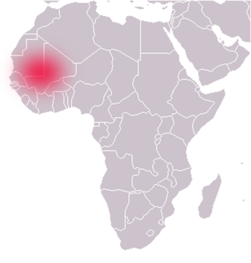| |
|
Atlas-country

|
Guinea
|
|
|
|
|
|
|
|
Guinée
|
|
|
|
| Français
|
Guinée - République de Guinée
La République de Guinée, parfois appelée Guinée Conakry, est un pays du nord-ouest de l'Afrique. La Guinée se trouve sur la côte atlantique de l’Afrique de l'Ouest et est entourée de la Guinée-Bissau (386 km de frontières), du Sénégal (330 km), du Mali (858 km), de la Côte d'Ivoire (610 km) du Liberia (563 km) et de la Sierra Leone (652 km) et de l'océan Atlantique.
|
| Fulfulde
|
Gine- République de Guinée
Gine ko leydi e Afirik Hirnaangeeri. Hindi kernidi e leyɗe ɗee ɗoo: Saralon, Liiberiyaa, Koddiwaar, Maali, Senegal e Gine-Bisaawo. Noone laamu mayri ko repibilik, e maanaa laamu renndaangu. Hooreejo leydi ndin ko Lansana Konte innetee, Hooreejo guwerneman maa Premier Ministre on ko Lansana Kouyate gila lewru fabraa'ilu 2007.
|
| English
|
Guinea - Republic of Guinea
The Republic of Guinea is a nation in West Africa, formerly known as French Guinea. Roughly a crooked finger pointing downward, the country could be said to begin at the Atlantic ocean, travel inland and then south. Guinea's land borders ► Guinea-Bissau and ► Senegal to the north, ► Mali on the north and north-east. The inland tip of that south-pointing finger borders the ► Côte d'Ivoire on the south-east, ► Liberia on the south, and ► Sierra Leone to the west of the finger's southern reach (see map.) Its territory encompasses the water source for the Niger, Senegal, and Gambia rivers, with a coastline facing the Atlantic Ocean.
|
|
|
|
| Short name
|
Guinea
|
| Official name
|
Republic of Guinea
|
| Status
|
Independent country since 1958
|
| Location
|
West Africa
|
| Capital
|
Conakry
|
| Population
|
1,624,945 inhabitants
|
| Area
|
245,857 square kilometres (94,926 sq mi)
|
| Major languages
|
French (official), Fula, Maninka, Susu, Wolof
|
| Major religions
|
Islam
|
| More information
|
Guinea, Geography of Guinea, History of Guinea and Politics of Guinea
|
| More images
|
Guinea - Guinea (Category).
|
|




















